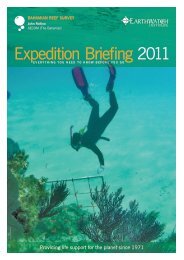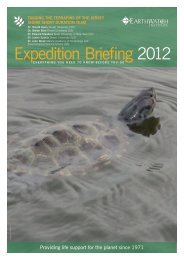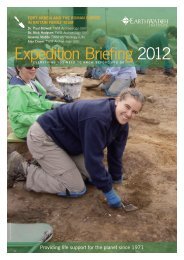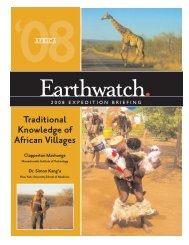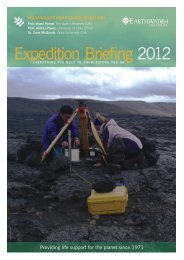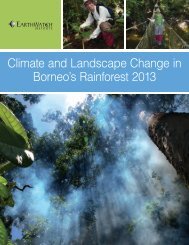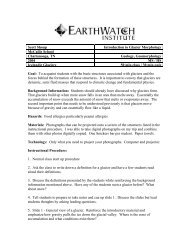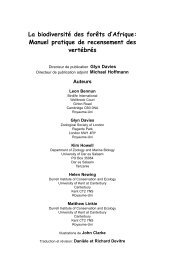Alaskan Fur Seals - Earthwatch Institute
Alaskan Fur Seals - Earthwatch Institute
Alaskan Fur Seals - Earthwatch Institute
Create successful ePaper yourself
Turn your PDF publications into a flip-book with our unique Google optimized e-Paper software.
APPENDIX<br />
ALASKAN FUR SEALS: THE RESEARCH<br />
The following information was taken from the research proposal submitted by the <strong>Earthwatch</strong> Scientist(s) to<br />
<strong>Earthwatch</strong> <strong>Institute</strong>. Included is a description of the research conducted through this project, some results to<br />
date, and other information regarding the accomplishments of the project and the staff. Specific details<br />
regarding research sites, methods, etc. is subject to change slightly from year to year and such changes may<br />
not be incorporated into this document.<br />
BACKGROUND, OBJECTIVES, AND METHODS<br />
The focus of the <strong>Alaskan</strong> <strong>Fur</strong> <strong>Seals</strong> research project is long-term monitoring of population age structure in the<br />
northern fur seals (Callorhinus ursinus) of the Pribilof Islands in Alaska. For long-lived animals such as marine<br />
mammals, understanding the age structure of the population is critical in assessing its future viability and health.<br />
Healthy populations have a mix of age groups. Decreases in different age groups have different consequences.<br />
For example, lack of recruitment (maturing young animals) in a population results in a gradual increase of the<br />
average reproductive age. In the short term, the result may be a slight decrease in the overall population. The<br />
delayed response, however, can be an accelerated population decrease and possibly a crash once the depressed<br />
numbers of younger animals mature and fail to sufficiently replace the primary breeding age group. Whether or<br />
not northern fur seals are currently experiencing age-biased population changes is unknown. If it were known, it<br />
could shed light on the cause of the current decline as well as indicate future population trends. The main goal of<br />
our current study is to test whether we can quantify changes in the age structure of breeding age northern fur seal<br />
females. The study began in 2004 and the methodology has been refined and proven successful (Robson et al<br />
unpublished data, 2007).<br />
Our ability to understand the factors influencing the current fur seal population decline is complicated by a lack<br />
of information on vital rates in the Pribilof population. At the moment, estimates of the total population are made<br />
using a correction factor derived from survival and fecundity estimates. These estimates are based on data<br />
collected from females collected at sea between 1958 and 1974 and whether or not they remain valid or have<br />
changed as the population declines is unknown. There is no current data available to compare age composition<br />
and fecundity to the 1950s data. As a result, there is insufficient information to evaluate whether reduced juvenile<br />
or adult survival is an underlying cause of the decline, or whether fewer females are returning to land and giving<br />
birth to pups. It is also possible given the precipitous rate of decline observed in recent years, that both factors<br />
may be in play. Little is known about juvenile survival after pups leave the Pribilof Islands, although substantial<br />
research efforts are currently underway to track the movement of pups during the winter migration. However,<br />
similar research efforts to study vital rates in the fur seal population are only just beginning. It is noteworthy in<br />
this regard that anecdotal observations of groups of mostly white-whiskered (older) females on the back edge of<br />
rookeries, appearing to be without pups, have been made in recent years by both local (G. Fratis, Island Sentinel<br />
Database, St. Paul Island) and scientific researchers (A. York, Pers. Comm.).<br />
The urgent need for updated information on fur seal vital rates is complicated by the logistical difficulty, expense<br />
and potential disturbance associated with the longitudinal studies required to obtain survival and fecundity<br />
estimates from marked individuals. Efforts are underway to evaluate a range of techniques for use in such longterm<br />
monitoring studies, but the studies are only in their initial stages. In addition, even in the event that longterm<br />
tagging studies are initiated soon, it will be 10 years or more before information on vital rates in the Pribilof<br />
fur seal population are available (e.g. see Boyd et al. 2001).<br />
25




